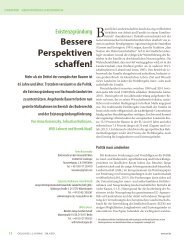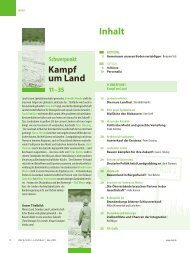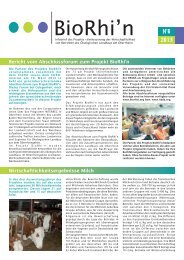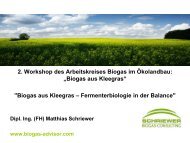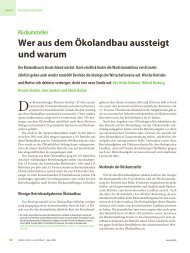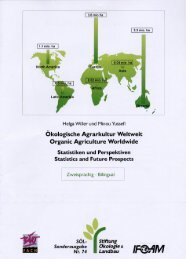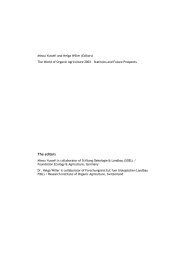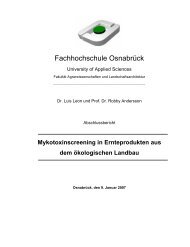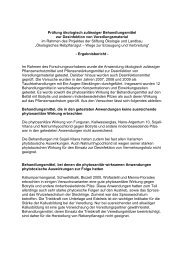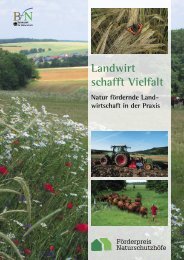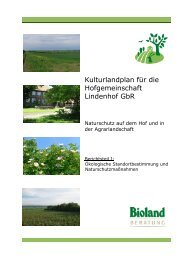the world of organic agriculture - Organic Eprints
the world of organic agriculture - Organic Eprints
the world of organic agriculture - Organic Eprints
Create successful ePaper yourself
Turn your PDF publications into a flip-book with our unique Google optimized e-Paper software.
15 <strong>Organic</strong> Farming in Europe<br />
In <strong>the</strong> European Union (EU) more than 5.8 million hectares are managed <strong>organic</strong>ally by almost<br />
140’000 farms. This constitutes 3.4 percent <strong>of</strong> <strong>the</strong> agricultural area and 1.5 percent <strong>of</strong> <strong>the</strong> farms<br />
in <strong>the</strong> EU. The increase in <strong>the</strong> European Union compared to <strong>the</strong> previous year is mainly due to<br />
high growth rates in <strong>the</strong> new member states (for instance Lithuania: + 100 percent, Poland + 60<br />
percent). The area under <strong>organic</strong> management is in most cases, however, not as high as in <strong>the</strong><br />
countries <strong>of</strong> <strong>the</strong> “old” European Union. The Czech Republic, though, has converted more than six<br />
percent <strong>of</strong> its agricultural land, which is a higher percentage than Germany has. But also in o<strong>the</strong>r<br />
countries like Portugal, Austria Germany, Greece <strong>the</strong> <strong>organic</strong> land area increased. Compared to<br />
<strong>the</strong> previous year in <strong>the</strong> EU <strong>the</strong>re has been a drop in <strong>the</strong> number <strong>of</strong> <strong>organic</strong> farms, due to <strong>the</strong><br />
decrease <strong>of</strong> <strong>the</strong> number <strong>of</strong> farms and land under <strong>organic</strong> management in Italy.<br />
Graph 13: Development <strong>of</strong> <strong>organic</strong> farming in <strong>the</strong> European Union 1985-2004. From 2003 <strong>the</strong><br />
New Member States are included (accession May 2004)<br />
Sources: Welsh Institute <strong>of</strong> Rural Sciences, UK-Aberystwyth, SOEL, D-Bad Dürkheim, FiBL, CH-Frick<br />
The difference between individual countries regarding <strong>the</strong> importance <strong>of</strong> <strong>organic</strong> farming is<br />
substantial. More than 13 percent <strong>of</strong> agricultural land is <strong>organic</strong> in Austria, more than 11 percent<br />
in Switzerland, around seven percent in Finland, Italy and Sweden. Some countries have yet to<br />
reach one percent. The country with <strong>the</strong> highest number <strong>of</strong> farms and <strong>the</strong> biggest <strong>organic</strong> land<br />
area is Italy. Almost one fifth <strong>of</strong> <strong>the</strong> EU’s <strong>organic</strong> land and almost a quarter <strong>of</strong> its <strong>organic</strong> farms<br />
are located here.<br />
According to <strong>the</strong> FiBL survey 2005 /2006 in Europe <strong>the</strong> <strong>organic</strong> agricultural land (6.5 million<br />
hectares) is mainly used for arable cropping (42 percent <strong>of</strong> <strong>organic</strong> land) and for permanent<br />
pastures (45 percent). Permanent crops amount for seven percent <strong>of</strong> <strong>the</strong> land. Only for six<br />
percent <strong>of</strong> <strong>the</strong> <strong>organic</strong> land no information on <strong>the</strong> main land use categories was available.<br />
131



